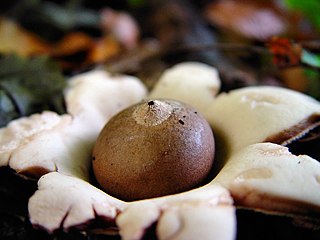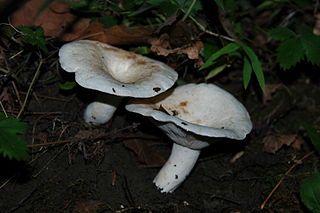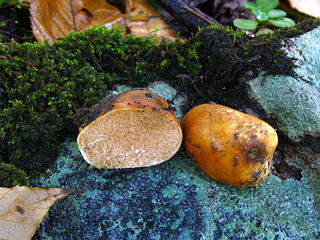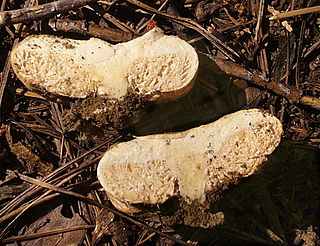Related Research Articles

Secotioid fungi are an intermediate growth form between mushroom-like hymenomycetes and closed bag-shaped gasteromycetes, where an evolutionary process of gasteromycetation has started but not run to completion. Secotioid fungi may or may not have opening caps, but in any case they often lack the vertical geotropic orientation of the hymenophore needed to allow the spores to be dispersed by wind, and the basidiospores are not forcibly discharged or otherwise prevented from being dispersed —note—some mycologists do not consider a species to be secotioid unless it has lost ballistospory.

The Russulaceae are a diverse family of fungi in the order Russulales, with roughly 1,900 known species and a worldwide distribution. They comprise the brittlegills and the milk-caps, well-known mushroom-forming fungi that include some edible species. These gilled mushrooms are characterised by the brittle flesh of their fruitbodies.

Lactarius is a genus of mushroom-producing, ectomycorrhizal fungi, containing several edible species. The species of the genus, commonly known as milk-caps, are characterized by the milky fluid ("latex") they exude when cut or damaged. Like the closely related genus Russula, their flesh has a distinctive brittle consistency. It is a large genus with over 500 known species, mainly distributed in the Northern hemisphere. Recently, the genus Lactifluus has been separated from Lactarius based on molecular phylogenetic evidence.

Russula is a very large genus composed of around 750 worldwide species of ectomycorrhizal mushrooms. They are typically common, fairly large, and brightly colored – making them one of the most recognizable genera among mycologists and mushroom collectors. Their distinguishing characteristics include usually brightly coloured caps, a white to dark yellow spore print, brittle, attached gills, an absence of latex, and absence of partial veil or volva tissue on the stem. Microscopically, the genus is characterised by the amyloid ornamented spores and flesh (trama) composed of spherocysts. Members of the related genus Lactarius have similar characteristics but emit a milky latex when their gills are broken. The genus was described by Christian Hendrik Persoon in 1796.

Lactarius torminosus, commonly known as the woolly milkcap or the bearded milkcap, is a large species of agaric fungus. A common and widely distributed species, it is found in North Africa, northern Asia, Europe, and North America. It was first described scientifically by Jacob Christian Schäffer in 1774 as an Agaricus, and later transferred to the genus Lactarius in 1821 by Samuel Frederick Gray. A variety, L. torminosus var. nordmanensis, is known from the United States, Canada, and Switzerland. L. torminosus officially became the type species of Lactarius in 2011 after molecular studies prompted the taxonomic reshuffling of species between several Russulaceae genera.

Milk-cap is a common name that refers to mushroom-forming fungi of the genera Lactarius, Lactifluus, and Multifurca, all in the family Russulaceae. The common and eponymous feature of their fruitbodies is the latex ("milk") they exude when cut or bruised. Mushrooms with typical milk-cap characteristics are said to have a lactarioid habit. Some of them are edible.

Geastrum is a genus of puffball-like mushrooms in the family Geastraceae. Many species are commonly known as earthstars.

Lactifluus piperatus, commonly known as the blancaccio, is a semi-edible basidiomycete fungus of the genus Lactifluus. Despite being edible, it is not recommended by some because of its poor taste, though can be used as seasoning when dried. The fruiting body is a creamy-white mushroom which is funnel-shaped when mature, with exceptionally crowded gills. It bleeds a whitish peppery-tasting milk when cut. Widely distributed across Europe and eastern North America, Lactifluus piperatus has been accidentally introduced to Australia. Mycorrhizal, it forms a symbiotic relationship with various species of deciduous tree, including beech, and hazel, and fruiting bodies are found on the forest floor in deciduous woodland.

Lactarius blennius is a medium-sized mushroom of the genus Lactarius found commonly in beech forests in Europe, where it is mycorrhizal, favouring the European beech. It was first described by Elias Magnus Fries. Though its colour and size vary, it is distinctive because it is slimy when wet and exudes copious amounts of milk. It has been the subject of some chemical research, and it can be used to produce pigments and blennins. Blennins, some of which have shown potential medical application, are derived from lactarane, a chemical so named because of their association with Lactarius. The edibility of L. blennius is uncertain, with different mycologists suggesting that it is edible, inedible or even poisonous.

Lactifluus volemus, formerly known as Lactarius volemus, and commonly known as the weeping milk cap or bradley, is a species of fungus in the family Russulaceae. It is widely distributed in the northern hemisphere, in temperate regions of Europe, North America and Asia as well as some subtropical and tropical regions of Central America and Asia. A mycorrhizal fungus, its fruit bodies grow on the ground at the base of various species of trees from summer to autumn, either individually or in groups. It is valued as an edible mushroom, and is sold in markets in Asia. Several other Lactifluus mushrooms resemble L. volemus, such as the closely related edible species L. corrugis, but these can be distinguished by differences in distribution, visible morphology, and microscopic characteristics. L. volemus produces a white spore print and has roughly spherical spores about 7–8 micrometres in diameter.
Roccellina is a genus of lichen-forming fungi in the family Roccellaceae.

Cystangium is a genus of fungi in the family Russulaceae. The genus contains 32 species that are distributed in Australia and South America. Cystangium was described by American mycologists Rolf Singer and Alexander H. Smith in 1960.

Lactarius sanguifluus, commonly known as the bloody milk cap, is a species of fungus in the family Russulaceae. First described from France in 1811, the species was given its current name by Elias Fries in 1838 when he transferred it to Lactarius. Found in Asia, Mediterranean Africa, and Europe, fruit bodies (mushrooms) grow scattered or in groups on the ground under conifers, especially Douglas fir. When bruised or cut, the fruit bodies ooze a blood-red to purple latex that slowly turns greenish upon exposure to air. The caps are orangish to reddish-brown, and become funnel-shaped with age. The gills are pinkish to purplish. Different forms have been described from Italy, but these are not universally accepted as distinct. L. sanguifluus mushrooms are edible, and sold in rural markets of Europe and Asia. Fruit bodies grown in polluted soil, including roadsides subject to heavy traffic, can bioaccumulate toxic heavy metals. Several sterols and pigment have been isolated and identified from the mushrooms.

The gasteroid fungi are a group of fungi in the Basidiomycota. Species were formerly placed in the obsolete class Gasteromycetes Fr., or the equally obsolete order Gasteromycetales Rea, because they produce spores inside their basidiocarps rather than on an outer surface. However, the class is polyphyletic, as such species—which include puffballs, earthstars, stinkhorns, and false truffles—are not closely related to each other. Because they are often studied as a group, it has been convenient to retain the informal (non-taxonomic) name of "gasteroid fungi".

Zelleromyces is a genus of fungi in the family Russulaceae. It was first described by mycologists Rolf Singer and Alexander H. Smith in 1960 to contain hypogeous (underground) fungi with gasteroid fruit bodies that "bleed" latex when they are cut.

Lactifluus is one of three genera of mushroom-forming fungi containing species commonly named "milk-caps", the others being Lactarius and Multifurca. It has been separated from Lactarius based on molecular phylogenetic evidence but is very similar to that genus. There are roughly 150 known Lactifluus species, which have a mainly tropical distribution but are also found in the north temperate zone and Australasia. Some of them are edible mushrooms.

Arcangeliella is a genus of gasteroid fungi in the family Russulaceae. Taxonomic and phylogenetic research has shown that it is very likely a synonym of Lactarius. The type species Arcangeliella borziana was moved to Lactarius in 2003. However, the genus name is still in use for several species for which new combinations have not yet been proposed.

Arcangeliella crassa, commonly known as the gasteroid milk cap, is a North American secotioid fungus species in the family Russulaceae. Like other members of its genus, it should probably be transferred to the genus Lactarius. It was described from a collection made in Stanislaus National Forest, Northern California.

Zelleromyces cinnabarinus is a North American gasteroid fungus species in the family Russulaceae with a cinnabar-red peridium. It is the type species of Zelleromyces, and like other members of its genus, it should probably be transferred to the genus Lactarius which it belongs to phylogenetically. It was described from a collection made under pine in Jackson, Louisiana.
Gastrolactarius camphoratus is a species of fungus native to the Pacific Northwest of North America. Initially described as Elasmomyces camphoratus in 1960, it gained its current name in 2004.
References
- ↑ Vidal JM. (2004). "Arcangeliella borziana and A. stephensi, two gasteroid fungi often mistaken. A taxonomic revision of Lactarius-related sequestrate fungi". Revista Catalana de Micologia. 26: 59–82.
- ↑ Kirk PM. "Species Fungorum (version October 2014). In: Species 2000 & ITIS Catalogue of Life". Archived from the original on 2020-05-13. Retrieved 2014-11-26.
- ↑ Buyck B, Hofstetter V, Verbeken A, Walleyn R (2010). "Proposal to conserve Lactarius nom. cons. (Basidiomycota) with conserved type". Taxon. 59: 447–453. doi: 10.1002/tax.591031 .
